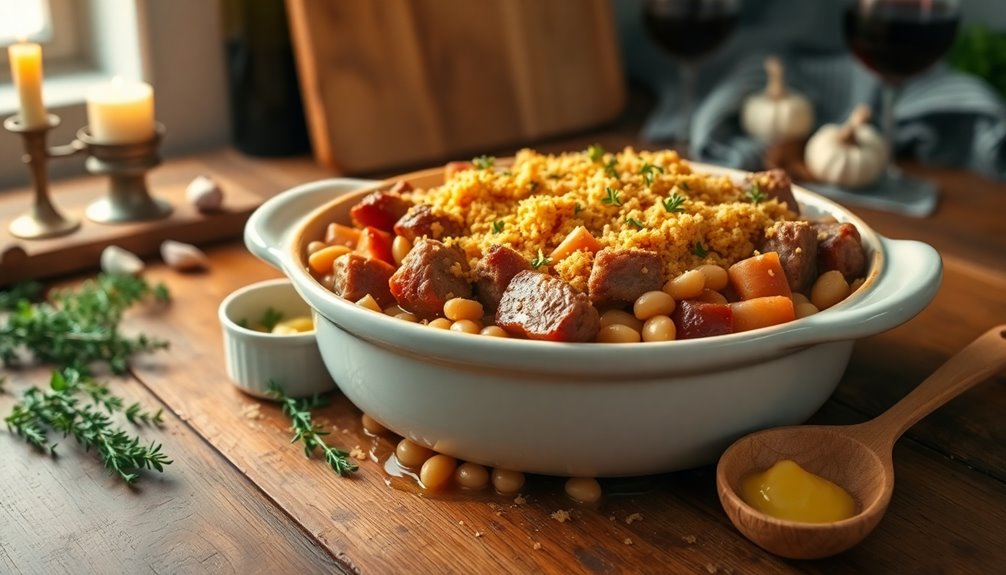Cassoulet's a classic French dish from the Languedoc region, and it's all about hearty flavors. You'll find a mix of pork, mutton, and beans slow-cooked with aromatic vegetables. Traditionally made with salt pork, pork shoulder, and sausages, this dish develops a rich, crispy crust during baking. It's perfect for enjoying with a fresh salad. If you're curious about how to make this comforting meal or its fascinating history, there's more to discover.
History
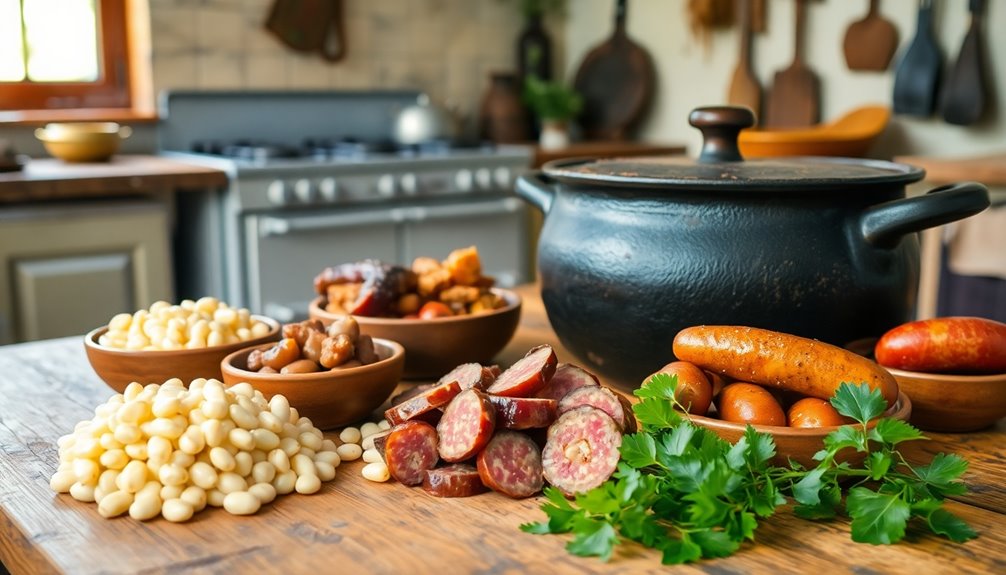
Cassoulet has a rich history that dates back to the Languedoc region of France during the Hundred Years War, with its roots traced to Castelnaudary around 1355.
Originally known as "estouffet," the dish was first referred to as cassoulet in the 19th century. Its name comes from the Languedoc word "cassolo," referring to the earthenware pot used for cooking.
Authentic cassoulet contains at least 30% pork, mutton, or preserved goose, along with up to 70% haricot beans. This hearty dish carries immense cultural significance, fostering local pride and tradition.
You'll find various regional claims to its authenticity from Castelnaudary, Carcassonne, and Toulouse, each offering distinct flavors and techniques that highlight the dish's rich heritage.
Recipe
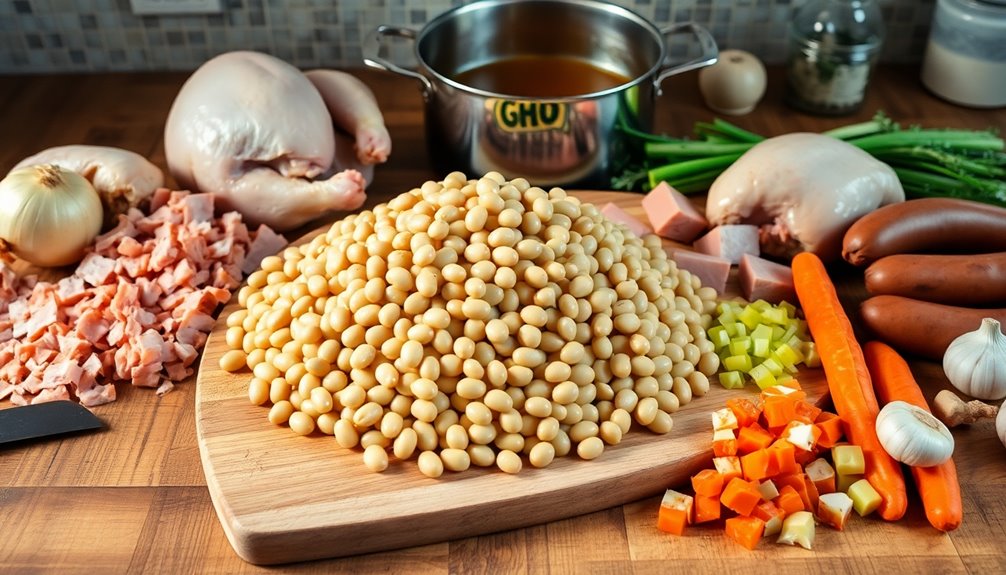
Ingredients:
- 1 pound dried cannellini beans
- 1 pound salt pork, diced
- 1 pound pork shoulder, cut into chunks
- 2 chicken or duck thighs
- 1 pound sausage (such as Toulouse or any good-quality sausage)
- 1 onion, chopped
- 1 carrot, diced
- 1 celery stalk, diced
- 4 cloves garlic, minced
- 4 cups homemade chicken stock
- 2 bay leaves
- Fresh thyme sprigs
- Salt and pepper to taste
- Breadcrumbs
- Duck fat or olive oil for topping
Cooking Instructions:
Start by soaking the dried cannellini beans in water overnight. The next day, drain the beans and set them aside.
In a large Dutch oven, brown the salt pork, pork shoulder, and sausages over medium-high heat until they develop a nice crust. Remove the meats and set aside.
In the same pot, add the onion, carrot, celery, and garlic, sautéing until softened. Return the meats to the pot along with the soaked beans, chicken stock, bay leaves, thyme, and season with salt and pepper.
Bring to a simmer, then cover and transfer to a preheated oven at 300°F (150°C). Bake for about 2 hours, checking occasionally and adding more stock if needed.
After 2 hours, remove from the oven, break the crust that has formed on top, and sprinkle with breadcrumbs mixed with duck fat. Return to the oven for another hour, allowing the crust to form again.
Extra Tips:
For the best flavor, use high-quality homemade chicken stock, as it adds richness to the dish.
Keep an eye on the cassoulet while it's baking; the crust should be golden and crispy but not burnt. If you find it browning too quickly, you can cover it loosely with aluminum foil.
Additionally, feel free to customize your cassoulet by adding your favorite meats or adjusting the herbs to your taste. This dish often tastes even better the next day, so consider making it in advance!
Cooking Steps
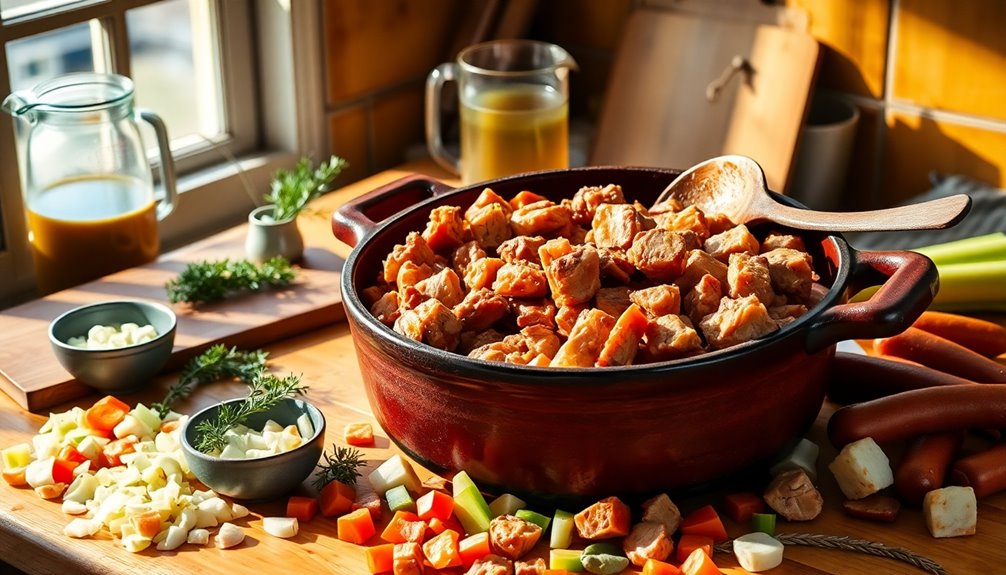
To start your cassoulet, you'll want to soak your dried cannellini beans overnight in salted water.
Once they're ready, heat some olive oil in a pot and sauté your aromatics to build a flavorful base.
After that, it's time to add the meat and soaked beans, letting everything simmer until tender.
Step 1. Soak Beans Overnight

Soaking your dried cannellini beans overnight is essential for achieving the perfect texture and flavor in your cassoulet. To do this, combine 1 cup of beans with 3 to 4 cups of salted water, ensuring the beans are completely covered.
As they soak, they'll absorb the water, swell, and become tender, ready to enhance your dish with their flavors during cooking. If you're short on time, you can use a quick soak method: boil the beans for 2 minutes, then let them sit in the hot water for 1 hour.
After soaking, make sure to rinse the beans thoroughly under cold water to remove excess salt and any impurities. This step sets the foundation for a delicious cassoulet.
Step 2. Sauté Aromatics in Olive Oil

After soaking the beans and preparing them for cooking, the next step is to build a flavorful base for your cassoulet.
Begin by heating olive oil in a Dutch oven or large pan over medium heat. Add diced onion, garlic, and other aromatics like celery and carrot, sautéing them until they're soft and fragrant, usually around 5-7 minutes.
Stir frequently to prevent browning; this allows the aromatics to release their natural sweetness and create a rich flavor base for the cassoulet. For an extra boost, toss in herbs like thyme or bay leaves during the sautéing process.
Once the aromatics are softened, you'll be ready to mix in the beans and continue crafting your delicious dish.
Step 3. Add Meat to the Pot
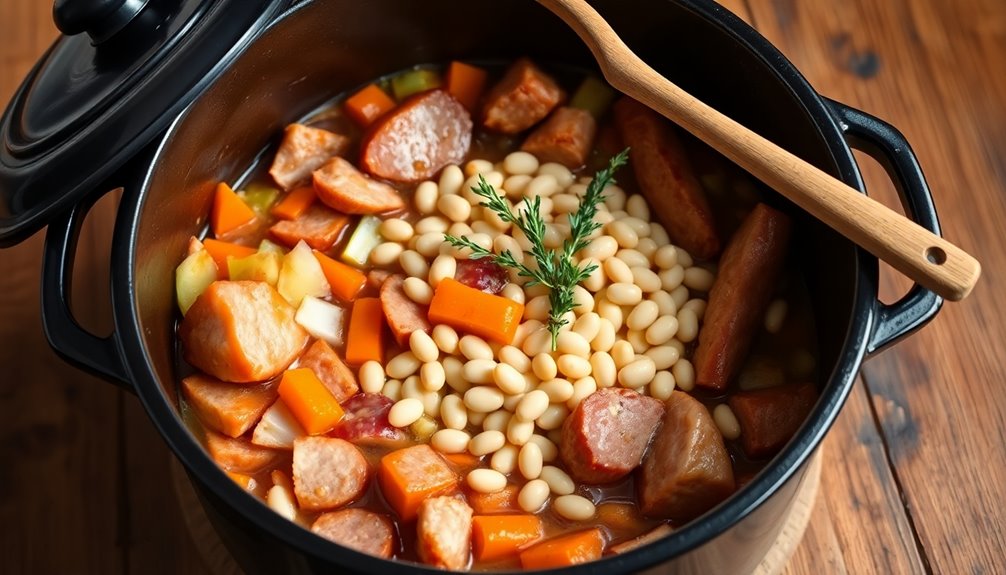
Start by browning your choice of meats, like chicken thighs and sausages, in the Dutch oven. This step's essential for developing rich flavors, so make sure the chicken releases easily from the pot, indicating proper browning.
As the meats cook, those browned bits will enhance your dish. Next, layer the browned meats over the cooked beans, and don't forget to add salt and any additional ingredients, like duck confit or salt pork, to deepen the flavor profile.
Pour reserved bean liquid over the layered meats, but don't fully cover them; this allows moisture while promoting a crust during baking.
With these traditional French techniques, you'll create a hearty, savory cassoulet that's sure to impress.
Step 4. Add Soaked Beans to Pot
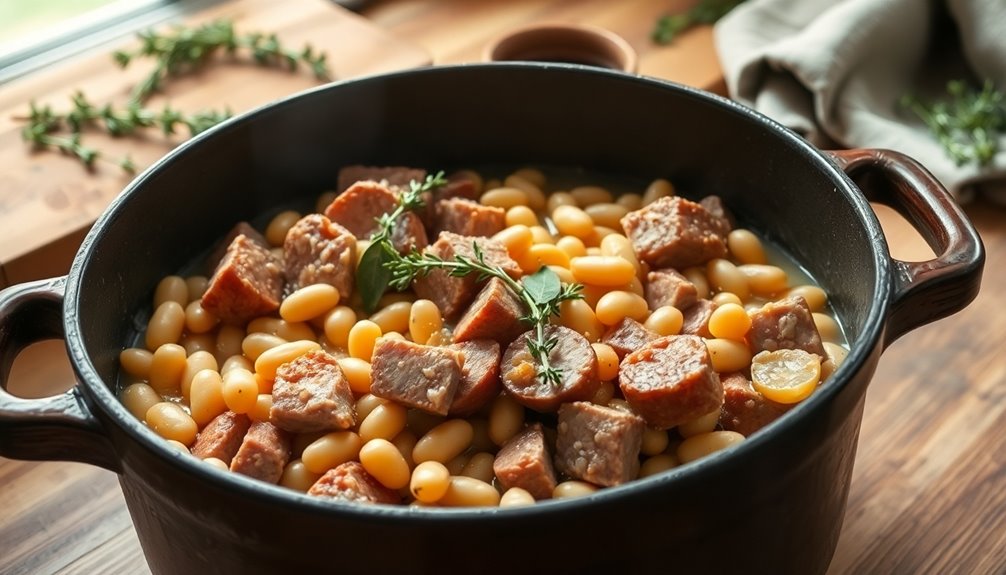
Once your beans have soaked overnight in salted water, drain and rinse them under cold water to eliminate excess salt and impurities.
Next, add the soaked beans to your pot, along with aromatics like onion, garlic, and herbs. This step infuses essential flavor into your dish during the cooking process.
Pour in enough stock to cover the beans completely, ensuring they're well submerged for even cooking. The stock not only hydrates the beans but also enhances the overall taste.
After that, bring the mixture to a gentle simmer. This allows the soaked beans to start softening before you incorporate the meats and sausages, creating a rich and balanced cassoulet that's sure to delight.
Step 5. Simmer Until Tender
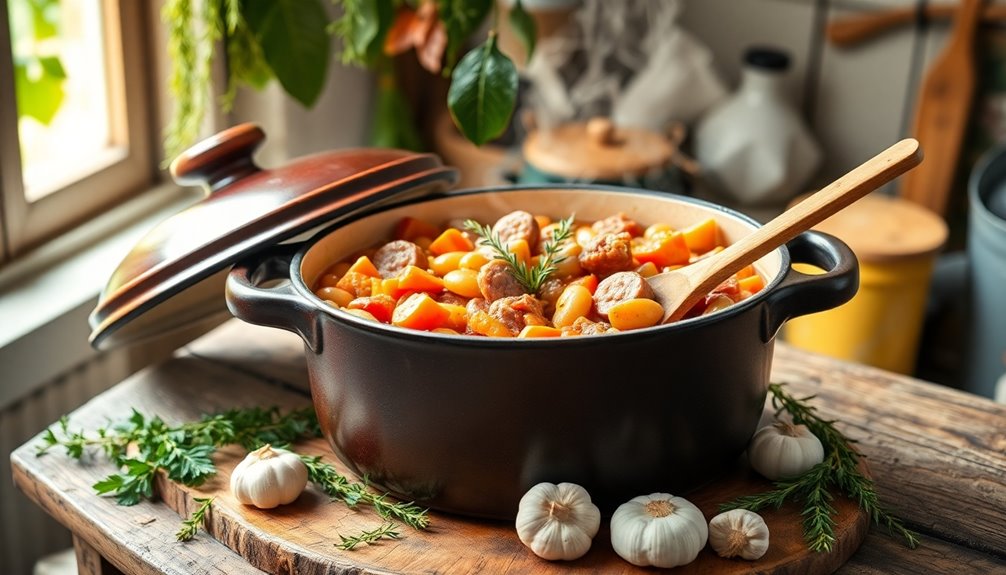
To achieve perfectly tender beans, simmer your soaked cannellini beans in a pot with the aromatic mixture for about 1.5 to 2 hours.
Begin by combining the beans with water, salt, and aromatics like onion and garlic. Bring the mixture to a gentle boil, then reduce the heat to a low simmer.
Make sure the beans stay submerged in the liquid throughout the cooking time, adding more water or stock as needed to prevent drying out. Periodically check for tenderness, as cooking times can vary based on bean freshness and heat.
Once the beans are tender, remove any whole aromatics before moving on to the final assembly of your delicious cassoulet. Enjoy the rich flavors that develop during this vital step!
Final Thoughts
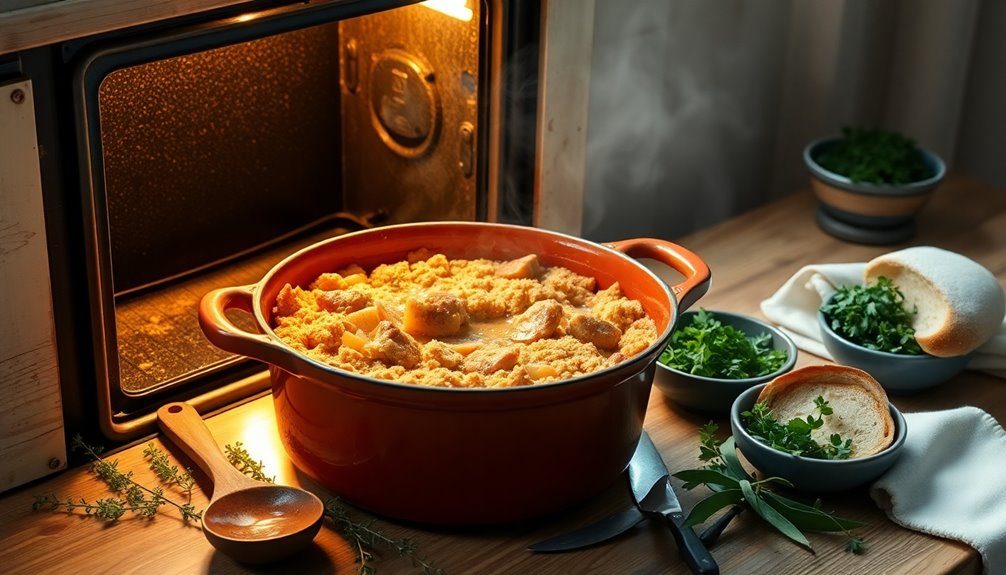
As you savor a bowl of cassoulet, it's easy to appreciate not only the dish's complex flavors but also the rich cultural heritage it represents. This traditional French meal highlights the pride of various regions, particularly Languedoc.
Perfectly cooked duck confit and pork meld beautifully with the smoky flavor of Great Northern beans, creating a comforting experience. The dark, rich crust, formed over hours of slow cooking, is a proof of the skill of home cooks. Remember to break the surface periodically for that golden finish.
For ideal flavor, let your cassoulet rest before serving, allowing the bean liquid and meats to harmonize. Pair it with a fresh green salad for a delightful balance. Enjoy the culinary journey!
Frequently Asked Questions
What Exactly Is Cassoulet?
Imagine a warm embrace on a chilly evening—that's what a hearty stew can feel like.
When you ask, "What exactly is this dish?" you're diving into a rich culinary tradition. It's a slow-cooked harmony of meats, beans, and flavorful stock, often crowned with a golden crust.
Each spoonful tells a story of comfort and warmth, inviting you to savor the deep-rooted culture and passion behind its creation.
You'll love every bite!
What Is the Holy Trinity of Cassoulet?
The Holy Trinity in many dishes often refers to three essential components that define their character. In this case, it includes haricot beans, a variety of meats, and a rich, flavorful stock.
You'll find that the beans absorb all the wonderful flavors, the meats add depth and texture, while the stock ties everything together, enhancing the overall taste.
Together, they create a hearty, satisfying experience that showcases the beauty of rustic cuisine.
Why Does Cassoulet Take so Long?
You might think that cooking a dish could take a lifetime, but in reality, it just feels that way when you're preparing something truly special.
It takes time because you're letting flavors meld, browning meats, and simmering beans all while creating that perfect creamy texture.
Plus, the overnight soaking of beans and the slow baking process for that rich crust can stretch the cooking time, but trust me, it's worth every minute!
What Does Cassoulet Mean in French?
In French, "cassoulet" refers to a traditional dish named after the cooking pot called "cassole." This term highlights the vessel used for preparing this hearty meal.
You might notice that each region in France has its own version of cassoulet, showcasing local ingredients and cooking styles.
The name embodies a rich culinary heritage, reflecting the pride and history of peasant cooking in the Languedoc region, making it significant to French culture.
